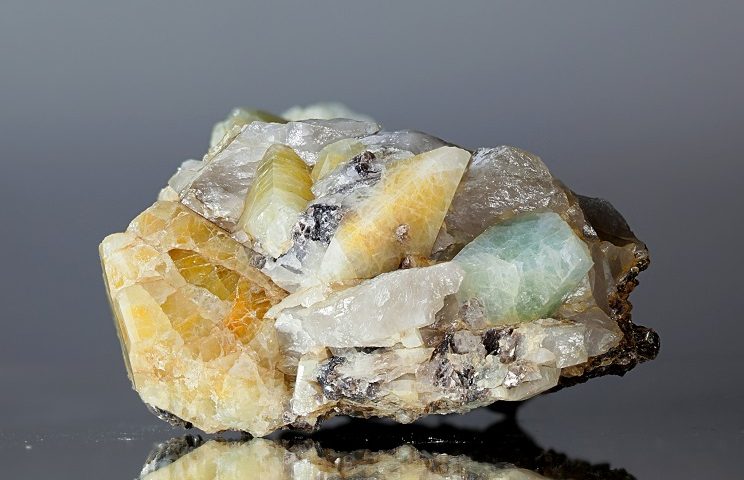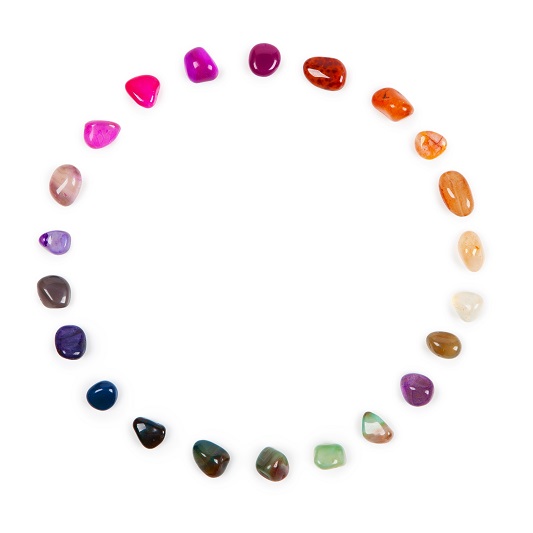Topaz: Gemstone of the Week

Moonstone: Gemstone of the Week
8th December 2017
Garnet, the gemstone of the week
21st December 2017Colourless in its pure form, Topaz is an aluminium silicate. The precious gemstone has a rich history that goes back thousands of years. The ancient Egyptians believed that yellow specimens received their vibrant colouring from the Sun God, Ra. It is unclear where the stones name originated from. Some believe that it is a Middle English word, acquired from the French word ‘Topace’ and Latin ‘Topazus’. ‘Topazion’ is the name of an island in the Red Sea where the Ancient Greeks first discovered yellow topaz. The name of the island means ‘to seek’ in Greek. It is believed to have been given this name because it was difficult to find. Others believe that the word ‘Topaz’ derived from the Sanskrit word ‘tapas’, which means ‘fire’. In this article, we explore the gemstone in more detail.
How to Identify Topaz
With specimens of Topaz appearing in an array of different colours, the stone is often confused with other gems such as Diamond, Ruby, Sapphire, Citrine, and Tourmaline. However, Topaz can easily be identified by its level of hardness. The stone measures around an 8 on the Mohs scale, whereas most of the stones with a similar appearance are softer. Sometimes, Topaz is also confused with Aquamarine, Spinel, and chrysoberyl. It can be distinguished from Aquamarine by its orthorhombic crystal structure, and from Spinel by its cubic crystal structure. Chrysoberyl typically has a higher density than Topaz, and unlike Topaz, it often shows no fluorescence.
Today, many gems are misleadingly sold as ‘Topaz’, with Madeira Topaz, Occidental Topaz, Palmeira Topaz, Rio Topaz, Scottish topaz, and Smoky Topaz being just a few. While these stones are similar in appearance to Topaz, in most cases they are actually Citrine Quartz or unusual specimens of sapphire.
Different Colours and Types of Topaz
In its pure form, Topaz is transparent and colourless. Typically, the stones are given their colour through natural trace impurities or defects in their structure. Like most gemstones, the colour of Topaz can be enhanced through heat treatment. Some of the most common colours of the stone today are orange, yellow, red, blue, pink, red, green, and brown.
Although coloured specimens are popular for use in gemstone jewellery, colourless Topaz is sought after, too. When given a brilliant cut, the stone can be sold as a substitute for Diamond. One of the most renowned specimens of Topaz in the world is a colourless stone that was originally thought to be a Diamond. Known as the Braganza Diamond, the stone boasted 1,680 carats and was owned by the royal family of Portugal.
Before undergoing heat treatment, the most common colours of topaz are yellow, brown, and grey. Pale shades of green, pink, and blue are sometimes found, too. In their untreated state, these specimens are rarely vivid in colour. Heat treatment is often used to produce more intense, vibrant hues. After treatment, the most popular Topaz colour is deep blue.
Where is Topaz Found?
Typically, Topaz is associated with igneous rocks of the granite and rhyolite type. The stone usually crystallises in granitic pegmatites or in vapour cavities in rhyolite lava flows. In various locations worldwide, the stone can be found with fluorite and cassiterite. These locations include Russia, Afghanistan, Sri Lanka, Czech Republic, Germany, Norway, Pakistan, Italy, Sweden, Japan, Brazil, Mexico, Australia, Nigeria, and the USA.
Today, Brazil is one of the largest sources of Topaz. Occasionally, Brazilian Topaz can be found in boulder-sized specimens. Instead of being sold on the gemstone market, crystals of this size and nature will typically be used in museums. Notable specimens of the stone have also been found in other areas of the world, too; For instance, a stone found in America named the ‘Golden Topaz’, weighed a whopping 22,892.5 carats. An impressive specimen found in Zimbabwe in the late 1980s is also famous, loved for its large size and natural, vivid blue colouring.
Healing Properties of Topaz
With many similar properties to Quartz, Topaz is popular within crystal healing. The powerful stone is believed to be balancing and calming. With the ability to balance emotions, release tension, and bring joy, Topaz is popular with people of all sorts. Great for those trying to lose weight, the gem stimulates the metabolism and aids digestion. Ancient tales state that the stone was used to increase the flow of blood and promote relaxation. Physically, Topaz is used today to ease symptoms of gout, and also aid blood disorders, tissue regeneration, and signs of ageing.
Vivid Blue Topaz is thought to promote artistic inspiration, in addition to strengthening the thyroid and respiratory system. It’s abilities to improve digestion make the stone ideal for those suffering from Crohn’s Disease, Inflammatory Bowel Disease, and Irritable Bowel Syndrome. Yellow topaz is believed to counteract low mood and ease irritability caused by lack of sleep. Yellow specimens are also placed on the bodies of those moving into the next realm, to encourage a peaceful transition.
In Summary
Although heat treated Topaz is readily available, natural specimens are rare and sought after – especially those with a vivid hue. Today, most of the Topaz on the market is mined from Brazil; however, smaller deposits can be found in other locations worldwide. Loved for its wide range of colours, fine-quality Topaz is often used in designer jewellery. Whether you’re looking for a valuable addition to your jewellery collection or you’re hoping to use the gemstone for its benefits within crystal healing, get your hands on a good-quality piece of Topaz to reap the benefits.




